Firstly, my apologies for the length of this post, and for the fact that, of necessity, there is repetition in some of the listed activities.
This post will be a first attempt at putting together the Learning Design for the Foundation Project. The participating institutions are: Manukau Institute of Technology, Wintec, UNITEC, North Tec, Whitireia, Otago Polytech, and Redbridge College (UK). All institutions have foundation programmes, but there is no uniformity as to how and where interviewing skills are built into the respective programmes. However, the institutions have reached agreement on the Learning Outcomes (referred to in this posting as LOs) for the pilot in Second Life.
There are two main LOs used in the teaching of interviewing within foundation programmes. The first LO is effectively taught in the classroom, while the second lends itself to the SL environment. These are:
- Basic elements required for job/HE course application are described and demonstrated
- Key interview skills and practices are discussed and demonstrated
It is important that the first LO is considered as the development occurs within SL, as it is possible to support what is being done in the classroom, in SL. However, the second LO will be used as the ‘umbrella’ LO for SL development. This LO has in turn been broken down into smaller LOs. These are:
- Practice interview skills that deliver a positive personal impact
- Identify typical interview questions for different styles and types of interview
- Respond to typical interview questions appropriately, positively, and accurately
- Identify and practice interview skills for extracting information for a purpose
- Build greater confidence in using the English Language in daily life through the interview experience
- Participate in a full mock interview and provide and obtain feedback from the interview process
LO4 has been included for the students in Context 2 (see the previous blog post on Context), ie, pre-degree nursing students from UNITEC, while LO5 has been included for the students in Context 3, ie, ESOL students from North Tec.
The Learning Activities in this post will be designed to satisfy these Learning Outcomes.
Phases:
Three phases have been identified for this project. Only the first phase will be detailed in this post. The phases are:
Phase 1:
- Creating basic activities that help students to recognise a successful interview
- Providing activities where students are given the opportunity to make positive choices that will lead to successful interview outcomes
- Providing activities where students can develop an understanding of questions that could be asked in an interview, and how best to answer these questions in order to promote a positive image
- Providing activities where lecturers are able to support the students as they develop their interviewing acumen
- Providing activities that can be accessed asynchronously for students to be able to practise their interviewing skills independently
(Elements will include: photoboard, outfits and hair, interview areas, notecards and noticeboards, animations, discussion and interview areas)
Phase 2:
- Providing more sophisticated interview scenarios, eg police, nursing, teaching, etc
- Creating activities that utilise a holodeck
(The holodeck, scenarios and new animations will be needed in this phase)
Phase 3:
- Creating a more holistic learning process by using real companies outside/inside SL or real job vacancies in SL
- Student activities will follow a step-by-step process from
- finding the job
- applying for the job
- preparing (researching the company/job requirements etc)
- going through the interview process to job selection.
- As can be seen, the Phases are closely tied to the LOs.
Stage 1
Initial Requirements:
As the foundation students will be entering SL as classes in the computer labs, there may be as many as 24 students entering at the same time. This means that there will need to be a dozen informal interview spaces and a dozen interview rooms, areas for group and class discussion, and an informal area for relaxing and chatting. Foundation students need to identify an area as their own and feel comfortable in that space if they are to work productively.
Providing an interview area for students is not new in Second Life. Kangan Bateman TAFE, one of the largest providers of technical and further education training in Victoria, Australia, has an existing SL build for the purpose of providing training in interview skills. Their larger student areas for discussion and presentation are well worth considering as exemplars.
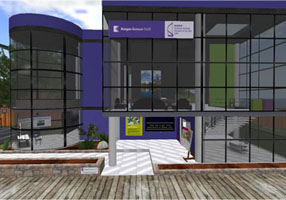
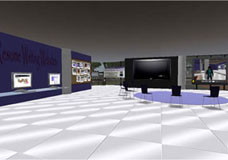
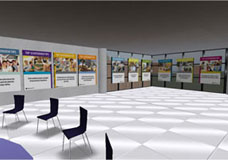
The foundation students who will be working in SL will need indoor areas that are open and easily accessible. A lot of the activities proposed could be outdoors, without the need for manipulating around walls and corners. Many educators in SL use these open spaces to great effect. Two examples are Empire State College and ISTE (International Society for Technology in Education). The photos below show an ESC classroom and a discussion area for ISTE students.
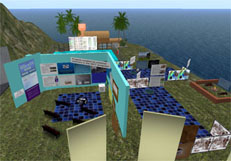
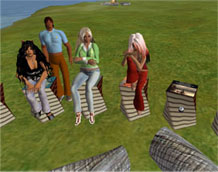
For all following activities, suggested Lesson Plans will be made available on Wiki Educator. It is recognised that lecturers in both Foundation and ESOL are used to a great deal of flexibility in planning their lessons and activities. The plans provided on Wiki Educator will be guidelines and recommendations only. The following activities are suggested:
Activity 1
Activity: Students dress for an interview.

Aims:
LO1 – Providing an activity where students need to make positive choices regarding clothing and hair, that will lead to successful interview outcomes. There is a further aim in providing this activity, ie, students will have only just completed Orientation, and this is a fun, simple, safe, useful activity to enable them to build their confidence in walking, sitting, clicking and selecting, dressing, and interacting.
LO5 – Providing an activity where students can practise the English language. Students will need to use active listening, follow instructions, and contribute ideas.
Prerequisite Knowledge/Activities:
- Students will need to have completed Orientation.
- Students will have already discussed some ‘do’s and ‘don’t’s of interviewing in class time, including the importance of personal presentation at an interview.
Activity Description:
- Students are shown the clothing/hair options (photoboard with selections). Students are told that there are some very good choices, some reasonable choices, and some bad choices.
- Students are told to select an outfit and a hairstyle that they believe is suitable for an interview.
- Students are told they can change using a screen, that they can click on their selection and use either ‘Replace Outfit’ or ‘Copy & Wear’ and they have only 2-3(?) minutes to make their selection before the wall will disappear.
- Students seat themselves in a large discussion area, and the lecturer leads them in a discussion regarding the reasons why students made certain choices. (It is envisaged that the discussion area will have a central place where demonstration role plays can take place for other activities. A red carpet or some sort of platform could be used in this activity for students to model their clothing selections. This again would give them practise in basic SL skills).
- (Optional) Students could be asked to write up a paragraph about their selection and experience. This could be written on a notecard and popped into a mailbox or passed to the lecturer.

(Required: clothing wall with outfits & hair, screens for changing, a dressing table/mirror (a fun type of mirror could be used where students can use animations as they look at themselves in the mirror – this can be patterned after the scripted dressing mirror available at Cape Breeze), a timer/clock, a seating area, red carpet/platform, and a mailbox.)
Activity 2
Activity: Roleplay a generic interview
Aims:
LO1, LO2, LO3 – Providing an activity where students can develop an understanding of questions that could be asked in an interview, and how best to answer these questions in order to promote a positive image Also, providing an activity where the lecturer is able to support the students by demonstrating what will be required before expecting the students to attempt an interview themselves. A further aim of this activity is to get the students actively involved in an interview and practising responses to typical interview questions.
LO5 – Providing an activity where students can practise the English language. Students will need to use active listening, follow instructions, and contribute ideas.
Prerequisite Knowledge/Activities:
- Students will need to have completed Orientation and the ‘Dress for an interview’ session.
- Students will have already discussed some ‘do’s and ‘don’t’s of interviewing in class time, and will have a list of basic interview questions that can be expected in a generic interview. A list of basic generic questions and a list of behavioural questions (more indepth) will be provided for students and discussed in class. (These question sheets will be made available on Wiki Educator. These questions will also be available as notecards in the interview practice rooms.)
Activity Description:
- A confident student is selected by the teacher to roleplay with the teacher in SL. This student will be given suggested answers to the interview questions and/or the opportunity to practise answering the questions prior to the class session. (A second lecturer or an actor can be the second participant in this interview.)
- Students all dress for an interview. The same 2-3(?) minute time limit can be given. Students are told that they will be practising interviews after they have watched a demonstration role-play.
- Students seat themselves in the large discussion area and observe the interview as it takes place. The interview can be recorded using machinima. This will enable lecturers to play back parts of the interview for discussion. This will also enable a bank of interview videos to be built up for use subsequently.
- Students discuss the interview before breaking into smaller groups for interview practice. (Optional) Students are also reminded how to operate the audio/video recording so they can record their own interviews.
- In groups of three students go into separate interview rooms. The generic questions (both basic & behavioural) are available by touch in the interview rooms.
- One student becomes the interviewer, one student the interviewee, and the third is the observer. Students practise answering the questions given from the prompts on the notecards. Students can swap their roles around, so they all get a turn at being interviewer, interviewee, and observer. Students then discuss their interviews and how they felt they performed in the different roles.
- Students return to the large discussion area for a winding up discussion, looking at how they felt about their interviews, and if there were any difficulties (either technical or regarding the interviews themselves).
- (Optional) Students could be asked to write up a paragraph about their interview roles and experiences. This could be written on a notecard and popped into a mailbox or passed to the lecturer. Another alternative would be for the students to write up their experiences on the web (if this is the method of choice used by the lecturer), or even typed up in a portfolio.
(Required: clothing wall & screens, seating area, mailbox (as already listed for Activity 1), video display in discussion area, interview rooms with chairs, table, box with notecards containing both basic & behavioural generic questions, audio/video recording capabilities, cushions, animations for hand shake, etc.)
Activity 3
Activity: Students discuss previous interview experiences.
(This may not be a suitable activity for Context 3 students, depending on their level of fluency in English.)
Aims:
LO2, LO3 – Providing an activity where students can reflect on an interview experience(s). They will need to be able to identify a type of interview, the type of questions used in that interview, and what the positive and negative aspects of the interview were. They will also need to identify whether the interview was successful or not.
Prerequisite Knowledge/Activities:
- Students will need to have completed Orientation.
- Students will have already discussed some ‘do’s and ‘don’t’s of interviewing in class time.
- In each group of students, there must be at least one student who has been through a job or course application interview.
Activity Description:
- Students are divided into 4-5 groups of 4-5 (this will vary with lecturer preference). The lecturer gives each group a set of written instructions (on a notecard) regarding the task they are about to do in groups. This set of instructions (which can be altered to suit individual classes) will be available on the Wiki Educator.
- Students separate into their groups (each group must have at least one member who has previously experienced an interview). Groups can use the informal interview areas.
- Instructions given to the students are briefly to:
- Discuss a previous interview – answer the what job/course (ie. what type of interview), where, when, what did interviewer/interviewee do, what questions were asked, how were they answered, what was the end result.
- Work as a group to produce a notecard that lists both the positive and the negative elements of the interview discussed.
- Drop the notecard in the mailbox – all members of the group must have their names on the notecard.
- A practice interview session can follow (if there is time). Students could dress for this practise session but this is not essential. (Perhaps students dress when they use the formal interview rooms, but elsewhere this is optional). The session can use the same groups, varying roles as interviewer, interviewee, and two observers. Or interviewer, interviewee, and support person. This could lead into a subsequent discussion of whanau/fono interviews.
(Required: informal interview areas, (possibly outdoors with seating, table, box with notecards containing both basic & behavioural generic questions – these question boxes can be located in both the formal interview areas & the outdoor informal areas), clothing wall & screens (optional).)
Activity 4
Activity: Students practise a selected interview type.
NOTE: This is a variation of Activity 2. The LOs and Prerequisites are the same as in Activity 2.
Activity Description:
- Students all dress for an interview. The same 2-3(?) minute time limit can be given.
- Students are divided into groups of three (interviewer, interviewee, and observer) and each group selects a basic interview scenario (they can choose from: police entry, nurse entry, job application for a salesperson at JB Electronics, job interview as a kitchen hand at Hell’s Pizza, or job interview as a ride supervisor at Rainbow’s End (contacts in these three companies have agreed to provide information for mock interviews).
- (Optional) Students can once again be reminded how to operate the audio/video recording so they can record their interviews.
- In groups of three students go into separate interview rooms. The generic questions (both basic & behavioural) are available by touch in the interview rooms, so are questions for their particular scenario. (Perhaps there could be three boxes in each interview room: one containing the basic generic, one containing the behavioural generic, and one with the sets of specific scenario questions – it would be best if lecturers could have this box unavailable unless required, to prevent earlier sessions from having access to the scenario questions.)
- One student becomes the interviewer, one student the interviewee, and the third is the observer. Students practise answering the questions from the notecards. Students can swap their roles around. Students then discuss their interviews.
- Students return to the large discussion area for a winding up discussion, looking at how they felt about their interviews, and if there were any difficulties.
- (Optional) Students could be asked to write up the session as in Activity 2.
(Required: clothing wall & screens, seating area, mailbox (as already listed for Activity 1), interview rooms with chairs, table, boxes with notecards, audio/video recording capabilities, cushions, animations for hand shake, etc.)
Activity 5
Activity: Students practise a whanau/fono interview.
NOTE: This is a variation of Activity 2. The LOs and Prerequisites are the same as in Activity 2.
Activity Description:
- Students seat themselves in the large discussion area and watch a short video on whanau/fono interview.
- Students select either a whanau or fono interview. Students are then divided into groups of 4-6 (interviewer, interviewee, and assigned roles as family/support people). Guidelines for support people are provided on notecards, as well as extra guidelines for interviewers – how to acknowledge support people, ask for their input, give them time to speak, etc.
- Students all dress for the interview to suit their roles. The same 2-3(?) minute time limit can be given.
- Student groups will need to use the informal interview areas for this session as there will not be enough room or chairs in the more formal interview rooms(?). The same boxes with questions on notecards can be used.
- Students practise answering the questions from the notecards. Support people are invited to speak and contribute to the interview. Students then discuss their interviews.
- Students return to the large discussion area for a winding up discussion, looking at how they felt about their interviews, and how these interviews were different to previous interviews.
- (Optional) Students could be asked to write up the session as in Activity 2.
(Required: clothing wall & screens, seating area, mailbox (as already listed for Activity 1), informal interview areas with seating, table, boxes with notecards, notecards with extra information for whanau/fono interviews, animations for hand shake, etc.)
Activity 6
Activity: Obtain information as an interviewer
(This may not be a suitable activity for Context 3 students, depending on their level of fluency in English.)
Aims:
LO5 – Providing an activity where students determine the preparatory steps for obtaining information as an interviewer, and how to ask suitable questions to obtain information. A further aim of this activity is to allow students to obtain enough information from a Health Professional to write a report.
Prerequisite Knowledge/Activities:
- Students will need to have completed Orientation and the ‘Dress for an interview’ session. It is also recommended that students have experience such as that in Activity 2, so they feel more confident in the interview setting.
- Students will have already discussed some ‘do’s and ‘don’t’s of interviewing in class time, and will have discussed open questions and how to use them to extract information. Students will have been given requirements regarding their assignment as an interviewer. (These requirements for these students will be made available on Wiki Educator. The requirements will also be made available on notecards within SL for easy access.)
Activity Description:
- Students seat themselves in the large discussion area and watch a short video of an interview with a health professional.
- Students all dress for an interview. A 2-3(?) minute time limit can be given.
- In groups of three students go into separate interview rooms. Questions for interviewers (to elicit information) are provided on notecards, as well as suggested scripts for those being interviewed. Information on this script could be used to answer the questions. Notecards for this activity could be obtained by touch from a different source to the generic/scenario boxes(?). (This could be a picture, a first aid box, or ?)
- Students can swap their roles around, so they all get a turn at being interviewer, interviewee, and observer. Students then discuss their interviews and how they felt they performed in the different roles.
- Students return to the large discussion area for a winding up discussion, looking at how they felt about their interviews, and if they were able to elicit the information they needed from the interviewee(s).
- (Optional) Students could be asked to write up a paragraph about their interview roles and experiences. They could possibly write up a few paragraphs of information on the person they interviewed, and submit this on a notecard to the lecturer.
(Required: clothing wall & screens, seating area, mailbox (as already listed for Activity 1), video display in discussion area, interview rooms with chairs, table, object with notecards containing open questions for interviewer & script for interviewee, audio/video recording capabilities, cushions, animations for hand shake, etc.)
Activity 7
Activity: Obtain information as an interviewer
(This may not be a suitable activity for Context 3 students, depending on their level of fluency in English.)
Aims:
As in Activity 6.
Prerequisite Knowledge/Activities:
- As in Activity 6, plus:
- Completion of Activity 6.
Activity Description:
- A number of guest health professionals are asked to help out as interviewers in SL.
- Students are allocated a day and time, as well as a location for interviewing a health professional.
- Students complete the scheduled interview as required. This interview can be audio, video taped (if required).
- Following the interview students need to write a report (as detailed in the document on Wiki Educator). This document is submitted to the lecturer as stated in the criteria.
(Required: as in Activity 6).
Activity 8
Activity: Complete a mock interview
Aims:
As in Activity 2, plus:
LO6 – Participate in a full mock interview and provide and obtain feedback from the interview process.
Prerequisite Knowledge/Activities:
- As in Activity 2, plus:
- Completion of Activity 2 (and preferably a number of other listed activities).
Activity Description:
- A number of guest interviewers are asked to assist in SL. These can be business people, other tutors, or senior students. These guest interviewers are provided with an assessment sheet for assessing the performance of the interviewees. (This will be available on Wiki Educator.)
- Students are allocated a day and time, as well as a location for their interviews.
- Students complete the scheduled interview as detailed. This interview can be audio, video taped (if required).
- Students must prepare for the interview by dressing appropriately, arrive on time and at the right location (formal interview rooms will have to be numbered). Students will need to demonstrate suitable behaviours throughout the interview process, from initiation to termination.
- Following the interview students receive feedback about their performance, are able to replay parts of the interview if they desire, and then get to write a reflection on their own performance. This can be submitted on a notecard through the mailbox or directly to the lecturer.
(Required: as in Activity 2).
Activity 9
Activity: Students practise skills and access resources independently (asynchronous learning experience)
Aims:
All LOs, except for LO6.
Prerequisite Knowledge/Activities:
- Students will need to have completed Orientation.
- Students will have already discussed some ‘do’s and ‘don’t’s of interviewing in class time.
- The materials provided here for students can be accessed at any time throughout the duration of the learning experience.
Activity Description:
- Students can access information from bulletin boards on the key points of interviewing. The information will be summarised on the bulletin board, and available in more detail on notecards at the bottom of each bulletin board. A similar system can be seen in the combination bulletin board/notecard holder seen in the picture from Danish Visions below. The content shown in the photo is obviously very different!
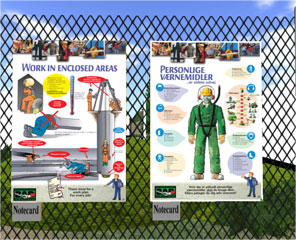
- Students can click on links to take then to web information on interviewing. Students can also click on web links for self-marking quizzes on interviewing. These links can appear on their own board.
- Students can enter a formal interview room where a robot avatar is scripted to ask the basic generic and behavioural generic questions. Students can record their responses and replay these to see how well they did.
- Students can sit in the large discussion area and touch for a selection of videos on interviewing. They can watch these videos at their leisure.
(Required: bulletinboards/notecards with information on interviewing skills, links to web information, links to quizzes, 2 formal interview rooms equipped as the regular formal interview rooms, robot avatar scripted for asking questions, audio capabilities. video display with selection of videos to view)
Activity 10
Activity: Fun interview activity
Aims:
All LOs, except for LO6.
A bit of fun to lighten the activities available.
Prerequisite Knowledge/Activities:
- Students will need to have completed Orientation.
- Students will have already discussed some ‘do’s and ‘don’t’s of interviewing in class time.
The materials provided here for students can be accessed synchronously and asynchronously (as long as students enter SL with at least one other student).
Activity Description:
- Students can enter the “fun” interview room with a partner. Students touch to select one of two fun interviews from a panel (ie as a Starship Trooper at Armageddon Pulp Expo, or as Santa’s Little Helper in the staged version of the Simpsons (the Simpson’s pet dog).)
- The student who chooses to be the interviewee has to select one of four possible outfits suitable for the interview. The outfits are displayed as pictures and the student does not have to wear the outfit. The student who is the interviewer records the interviewee’s selection on a touch screen.
- Students obtain notecards by touch. The interviewer has the questions that he/she is to ask the interviewee. The interviewee has possible answers (four for each question that he/she will be asked).
- As the interviewee answers each question, the interviewer records his/her answers on the screen. At the end of the interview a finish button is touched, and a score is given as to how appropriate the interviewee’s selections were.
(Required: one interview room, notecards with questions, and multiple-choice answers, pictures of outfits, a ‘game’ machine where the interviewer can input the interviewee’s answers, scripted ‘finish’ feedback.)


Great work Merle. It was especially nice to see, after all this time, a review of some of the thinking we arrived at on those face to face days. You post has covered those ideas concisely, added illustrations to help us picture it (love the last two images especially), and added new thinking.
One thing remains a bit unclear to me though..
Foundation students need to identify an area as their own and feel comfortable in that space if they are to work productively.
How will we do this? I might have missed it in reading through the activities, is it that the forming and dressing their avatars achieves this? Or should it be something more.. maybe prefabbed rooms and furnishings that they can use to fill a large empty space. Create their own village or something. A bit like some of the consumer virtual worlds offer. This sort of activity might be addressing LOs outside the scope of the foundation interview skills, but it might help achieve meta LOs.. things like a sense of community, appreciation of social structures, a sense of what it means to be a “contributing” member of society…
I’m looking forward to the meeting with your colleagues. I wonder if their is a way we can abbreviate these activity designs so there is more of a chance they will consider them. Maybe breaking them up into individual readers, with only the essential information, and passing those readers around at the meeting – leaving 2 – 3 minutes to read them before they discuss them…
Thanks for the post.
Hi Merle,
I concur with Leigh’s positive comments – the numerous possible presentations should be adaptable to all students.
May I assist in developing the interview questions? One of the complaints I hear from my online students is about the high turnover rates at some companies. The causes seem to be some combination of a poor job interview – not presenting the job well enough and/or an inadequate selection process on the part of the interviewer – as well as poor management practices in the company. I would like to help construct an interview process that not only prepares the students to clearly present their qualifications and abilities, but also teaches them to avoid jobs that would be unsuitable.
Thanks, Henry
Pingback: SLENZ Update, No 126, August 12, 2009 « Second Life Education in New Zealand